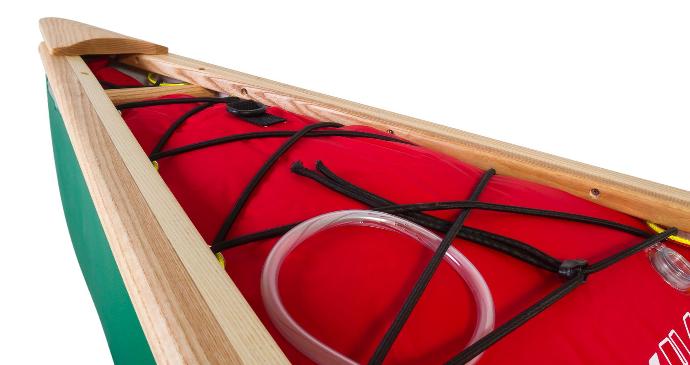Sometimes, doing a decent job isn't that much harder than cutting corners, and that's certainly true when we're going to drill holes in a prized canoe. Our top tip? Read on… and don't go overboard!
WHY "OUTFIT" AN OPEN CANOE?
Around the world, canoes are put out on the water and used just as they come from the factory - so what’s with this British tradition of drilling holes, threading rope and fitting airbags to “outfit” a brand new canoe?
An enthusiast might start with a photo of a pristine new canoe, with clean lines and an elegant simplicity that inspires thoughts of gliding effortlessly into the wilds… but end up with a canoe set up as if being put into military service.
The most appropriate solution for what we want to do could genuinely be the minimalist solution as more involved solutions are not always better.

In this blog, we're signposting tried and tested solutions, with a focus on getting our boat outfitted to suit us, rather than to suit someone else. For context, and applications, see our Outfitting a Canoe for Touring and Open Water and Outfitting a Canoe for Rivers and White Water blogs.
Do we need to outfit a canoe? Possibly not - and outfitting is never a good substitute for skills! Fortunately, good outfitting is not hard, and in some circumstances, appropriate outfitting can make a REALLY big difference.

OUTFITTING FOR OUR OWN PURPOSES
Our starting point should be that when it comes to outfitting, pretty much everything imaginable seems to have been tried by someone, somewhere…
What we've learned is:
Very few "tested" solutions are appropriate for all canoeists, in all situations… or even for comparable canoeists in similar situations;
Even where the solutions have been tested, copy-and-paste outfitting (doing what someone else does) can be worse than doing nothing at all;
In this first part of our two part guide, we look first at the basics of endloops, lacing and airbags. In Part II, we move on to Painters, Swimlines and Swimtails.
We can go fast and light on open water, which can help, especially where launching and landing is tricky. At the other extreme, we can set our canoes up like small yachts. Traditional Silverbirch Canoes are suited to either extreme, or to any compromise point in between.
DO WE REALLY NEED ENDLOOPS?
Ideas mostly get copied because they have been found by some to help solve problems. Classic endloops (designed to take forces of over one tonne) get talked up as offering an attachment point for boat recovery.
Do we all need endloops which can take massive forces?
Certainly not - especially if we’re primarily a touring canoeist - and especially as good ropework skills allow us to attach to a canoe in ways which will distribute big forces even if we don’t have endloops.

On the plus side, once we have got an endloop we also have somewhere to attach a painter, swimtail or swimline, and a tie down point we could use on the motorway - but if that were all we wanted, we might settle for something quite delicate. These are incidental benefits!
Quality endloops are easily arranged, easily maintained and inexpensive… and incidents can get out of hand almost anywhere… and those we are with are likely to assume we have quality endloops, so why wouldn't we fit them?

DO WE REALLY NEED LACING?
Some canoeists like to clip or tie items into their canoes. This might be for anything from airbags (see below) to portage packs… though in practice, it’s not uncommon to see clipping points used for nothing more than tiny items like phones and water bottles.
Do we need any of this? Well, that opens up into old arguments like whether our gear should be Lashed, Leashed or Loose. More importantly, it links into where we want to go and how we might want to sort ourselves out if something doesn’t go to plan.
Among touring canoeists, lacing is actually quite rare, and even on moderate white water we may prefer a few well placed d-rings and a handful of p-clips on the gunwales to drilling our canoe - but if we like the look, we can work on how to lace a canoe.
If we're ever in a situation where we wish we'd got something more than 4mm Dyneema lacing... we're getting beyond what we should be expecting to achieve with lacing! As a rule, 3mm Dyneema should suffice. The idea is simply to provide a frame for holding in airbags / kit.
WHO NEEDS AIRBAGS?
We see experienced trippers deep in the wilderness without them… so why on earth might we fit airbags for less extreme environments?
What questions might airbags answer? Maybe:
How could my canoe support me even when it's swamped?
How could I make manage self-rescue on the trips I do, or keep things simple for anyone who might rescue me?
How might I reduce the risk of my canoe getting trashed if I mess up?

We might be happy being a “wild swimmer” (abandoning our boat) if anything ever went wrong out on the water. We might always go out in a group with others who can rescue us in any conceivable situation. If neither apply, we might want to be able to sit in our swamped canoe whilst we work on our Plan B! For this, we're likely to need more than just "basic" flotation in our canoe.
Experienced canoeists without airbags may know they have strategies to cope in almost any conceivable situation so long as the canoe is just about floating. Others may cope so long as they have airbags. What really matters is having outfitting that is matched to our expertise!


Outfitting an Open Canoe